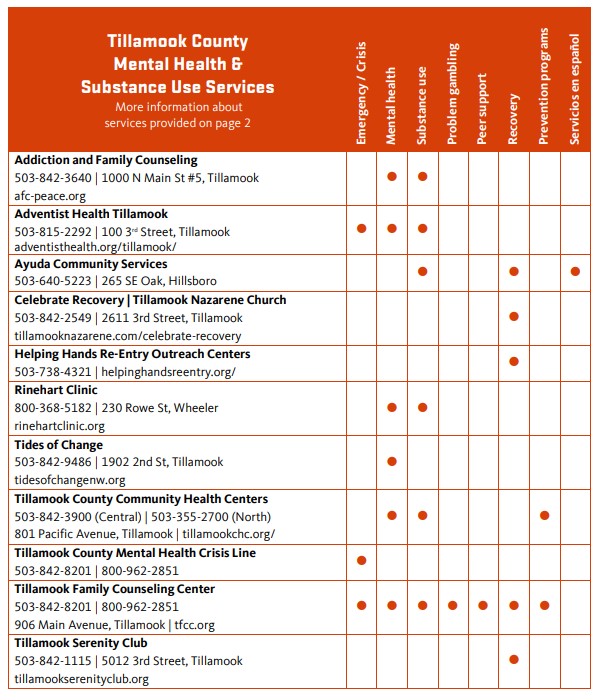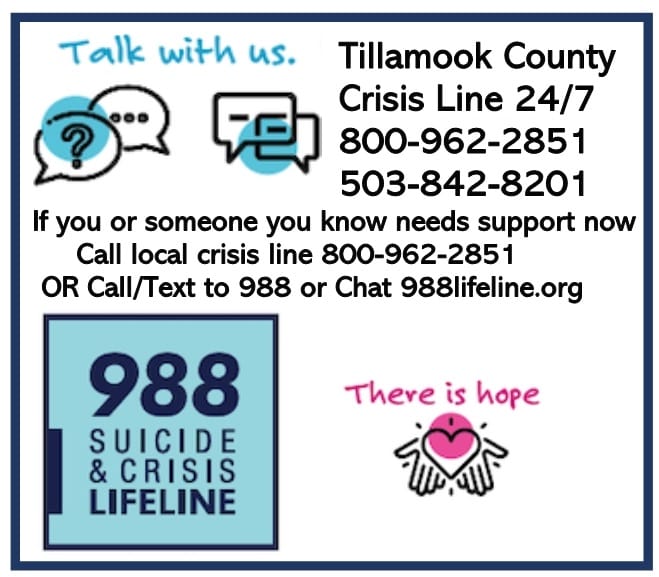By Leanna Coy, FNP-BC
Note: This article contains information about the idea of suicide. If you or someone you know is struggling with thoughts of self-harm, help is available.
Call or text 988 or chat at 988Lifeline.org
Tillamook County Crisis Line: 1-800-962-2851 or 503-842-8201
Older adults and people with disabilities, the Oregon Behavioral Health Initiative has professionals specializing in behavioral health. In Tillamook County, Helen Beaman LCSW, is available at 503-416-4781.
News of a suicide can shock and sadden a community. This is especially so in rural areas where the impact is greater due to smaller populations where people are more likely to know each other. One might assume this would translate to fewer suicides in those areas. Quite the opposite is true.
Suicides in rural areas are more common that urban areas. Tillamook County has suicide rates higher than both the national and state averages. In 2022, the most recent year statistics are available, nationally there were an average of 14.2 suicides for every 100,000 people. In Oregon, that rate increased to 19.3 for every 100,000. In rural Tillamook County, we had 33.2 per 100,000.
At the Pioneer, we hope to bring attention to this issue by talking about it. This article is part of a series openly discussing the topic of suicide. The goal is to empower those struggling to seek help.
Suicide is a public health issue
Suicide is a public health issue that many people find difficult to talk about. Suicide is death caused by an act of self-harm that is intended to end in death. In the United States, there are nearly twice as many suicides as homicides. Suicide ranks as the 10th leading cause of death in Oregon. Among teens, it is the 2nd leading cause of death. In Oregon, certain groups are more at risk for suicide. These include:
- People living in rural and remote communities
- Veterans, who comprise nearly 1/3 of all suicides in Oregon
- Men, especially older men, have more suicide deaths
- Women have more suicide attempts
- People of American Indian and Alaska Native Americans descent
- Non-Hispanic White individuals
- People in the LGBTQ2SIA+ community
Dealing with stigma
Often, a stigma is attached to suicide due to long-standing religious or moral beliefs. Suicide is commonly linked to mental health conditions, which have their own stigma. We need to move past that because research shows 46% of people who die by suicide had a known mental illness.
Mental illness is a condition affecting someone’s thinking, behavior, mood, or feelings. Mental health issues greatly impact a person’s daily activities and can affect how a person interacts and relates to others. Mental health conditions linked to suicide include:
- Depression
- Substance abuse
- Psychosis
- Anxiety
- Personality disorders
- Eating disorders
- Trauma related disorders
Mental illness is not a character weakness or flaw. Someone is not less of a person for having a mental illness. “Normal” people have mental health issues.
- 1 out of every 5 adults experience mental illness every year
- Every year 1 out of every 6 children ages 6-17 experience a mental health issue
- 75% of lifetime mental illness begins by the age of 14
With one out of every 5 adults experiencing mental illness, you or someone you know is likely dealing with an issue. Many factors play into mental health, including genetics, lifestyle, and environment. Traumatic life events, stress, and certain living situations make someone more likely to develop a mental illness. Frequently, those at risk for suicide are dealing with a combination of difficult life events and mental illness.
Why suicide rates are high in rural areas
Research shows for more than twenty years, rates of suicide in rural areas have been higher than in urban ones. Between 2000 and 2020, rates of suicide increased by 27.3% in metropolitan areas but jumped 46% in rural areas. Many factors go into why rates are higher outside of the cities:
- Cultural issues: The stigma related to acknowledging mental health issues or in seeking mental health care falls here. Traditional gender roles and expectations are strong in some rural communities, which can impact opportunities for women and those in the LGBTQ+ communities. Rural men are known to present as stoic, pushing through their issues without seeking help.
- Living in isolated locations: This reduces a sense of connection with others. Living remotely can also make it harder for someone to access available resources due to transportation issues or proximity.
- High cost of services: More people will lack insurance or have inadequate coverage to cover the cost of health care.
- Physical health: Rural communities have more people working in labor-intensive jobs. In Tillamook County, this would include crabbing, logging, farming, and housekeepers cleaning vacation homes, among many other jobs. Years of labor-intensive work contributes to more chronic pain or disability.
- Agricultural factors: Natural disasters such as drought, flooding, or wildfires can put economic pressure and lead to a sense of helplessness.
- Easy access: Access to firearms and pesticides are often greater in rural communities than in urban ones.
Caring for the community
Accessing care for mental health issues is a major problem. A shortage of primary care and mental health providers was made worse by pandemic. More than 49% of Americans live in an area where there is a shortage of mental health providers. Tillamook County has one mental health provider for every 400 people. The average in Oregon is one provider for every 210 people.
Virtual visits, also known as telehealth, gained popularity during the pandemic. This type of visit helps improve access to care for many living remotely. This type of visit also helps someone who is worried about the stigma associated with mental illness receive treatment in the privacy of their home. However, internet reliability in more remote areas can make this type of visit difficult or impossible for some.
We need to overcome any stigma around suicide and mental health. Talking openly about these issues will help increase awareness and normalize the conversation. If you are struggling, seek help. Talk with a friend, family member, or reach out to one of the help lines. If you are concerned about someone at risk for suicide, start the conversation.



